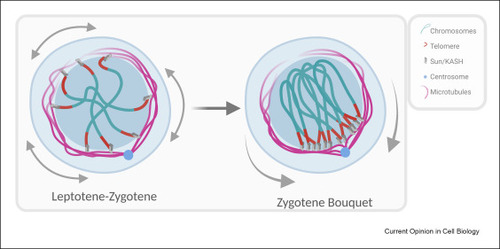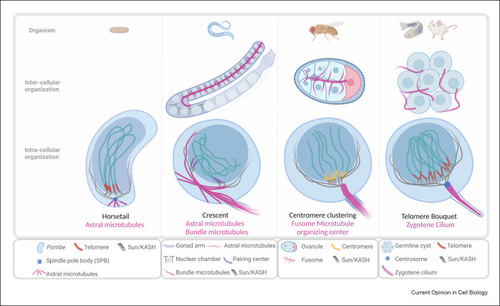- Title
-
The many faces of the bouquet centrosome MTOC in meiosis and germ cell development
- Authors
- Mytlis, A., Levy, K., Elkouby, Y.M.
- Source
- Full text @ Curr. Opin. Cell Biol.
|
The Bouquet dynamic and MTOC machinery. Left: at the leptotene stage, the onset of meiotic prophase, specific meiotic proteins mediate the binding of telomeres (red) to Sun/KASH complexes (light and dark grey) on the nuclear envelope (NE). Microtubules (MT; magenta) grow from the centrosome MTOC (blue circles) and organize perinuclearly. Association of Sun/KASH with MT via dynein slides telomere-bound Sun/KASH complexes on the perinuclear MTs, moving them on the NE (grey arrows). Telomere movements (arrows) shuffle chromosomes and contribute to their homology searches. Right: telomere sliding on the MTs via the dynein (−) end motor ultimately pulls telomeres toward the centrosome side of the nucleus (grey arrows), clustering them while their chromosomes loop to the other side, and forming the bouquet configuration. Variations of this conserved machinery are discussed in the text. |
|
Anchoring strategies of the bouquet MTOC machinery. Bouquet and bouquet-analogous configurations are shown in different species. In all cases, telomeres (S. pombe, zebrafish, and mouse), centromeres (Drosophila), or pairing centers (C. elegans) are bound to Sun/KASH complexes on the NE and moved by dynein on perinuclear MTs as shown in Figure 1. The potential anchor (magenta) and its intercellular and intracellular organizations are shown for each species. In S. pombe, the centrosome (spindle pole body, SPB) is anchored through MT to the cytoplasmic membrane. In the C. elegans gonads, germ cells are organized in nuclear chambers (see text), and perinuclear MTs are anchored to the cytoplasmic membrane of nuclear chambers. Some perinuclear MTs extend into the rachis and join a common network of bundles that runs through the gonadal arm, the anchoring functions of which have yet to be tested. In Drosophila, perinuclear MTs are prominently organized from the fusome, which runs through the germline cyst in the egg chamber and could function as an anchoring scaffold. In zebrafish, the bouquet centrosome is anchored by the zygotene cilium, which is likely in mice as well. |


